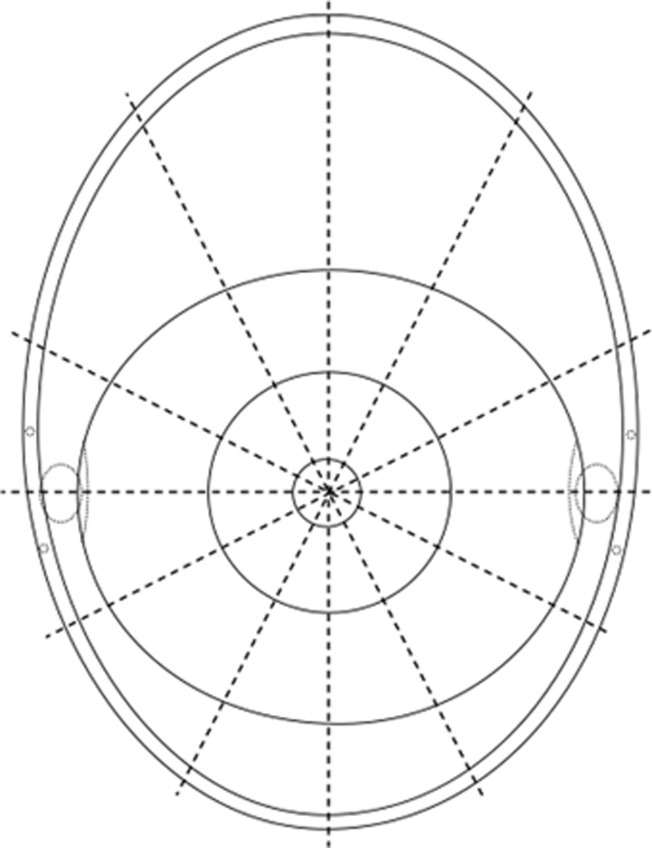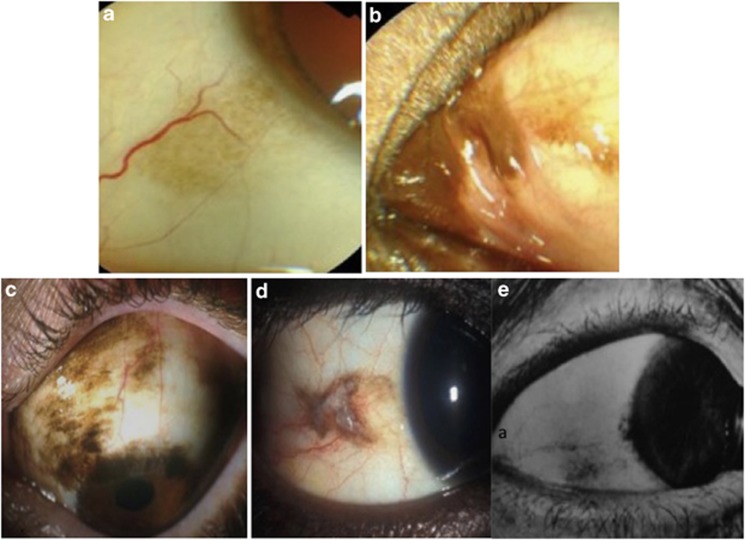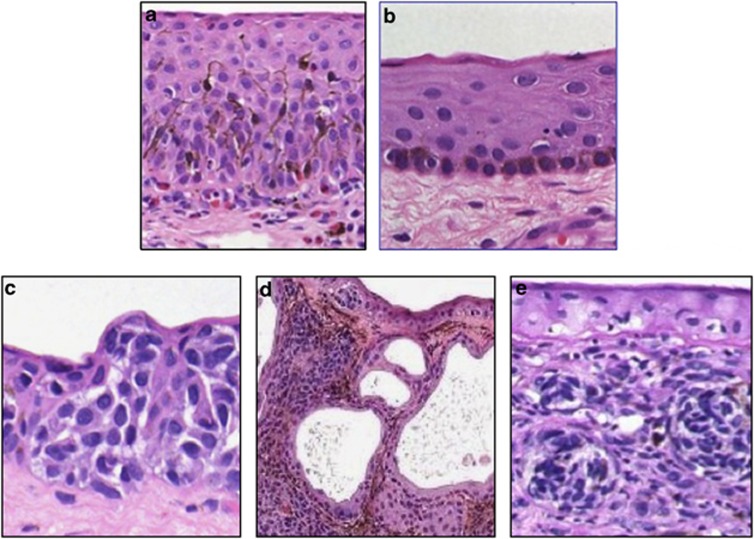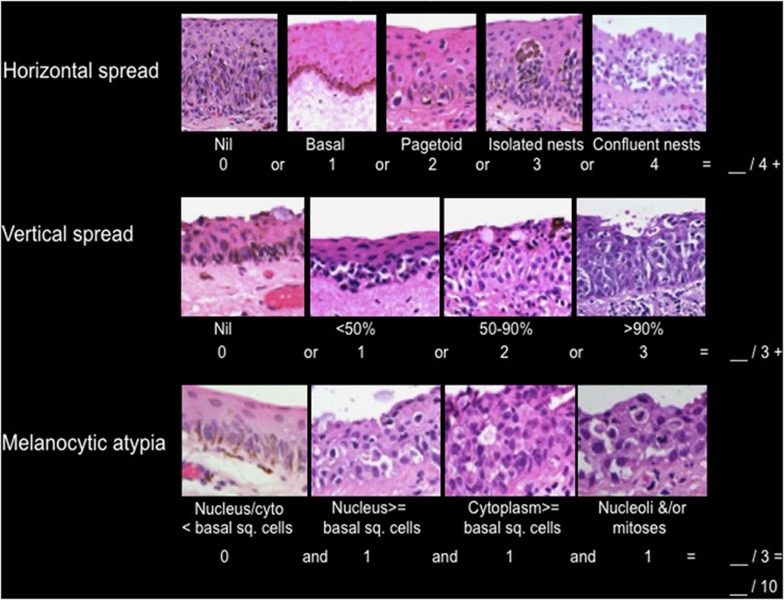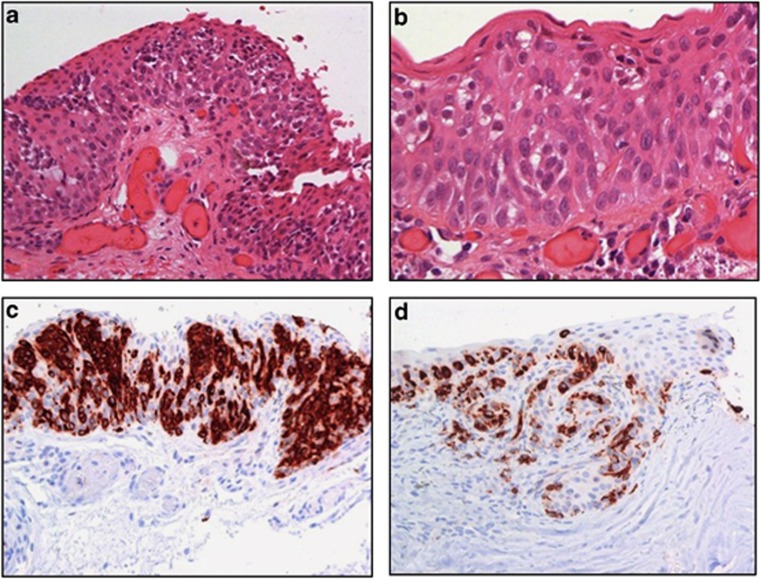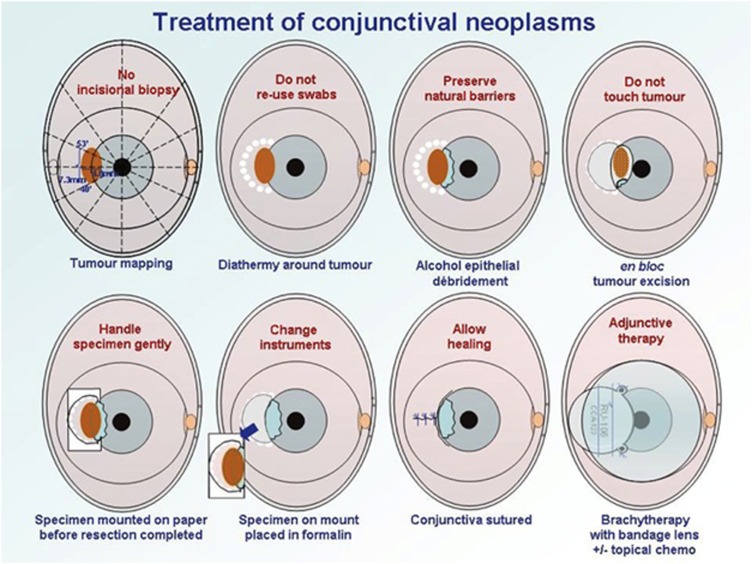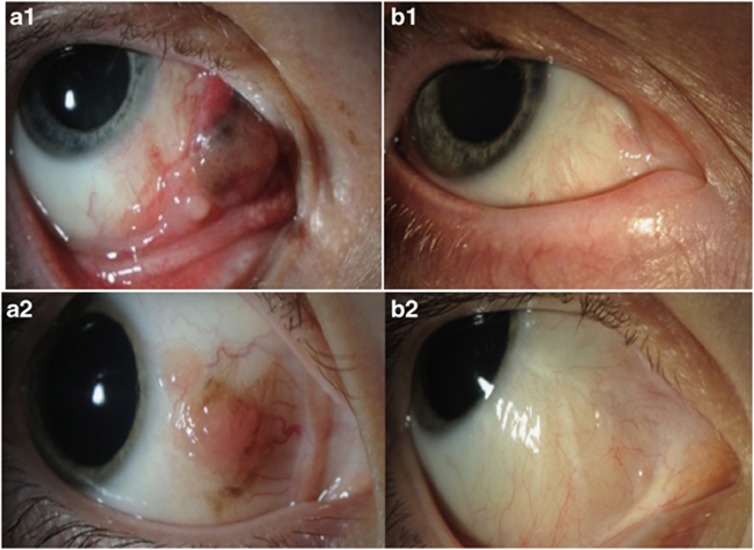Abstract
The rarity of conjunctival melanoma has impeded progress in the management of patients with this cancer; however, much progress has occurred in recent years. Primary acquired melanosis is now differentiated histologically into hypermelanosis and conjunctival melanocytic intra-epithelial neoplasia, for which an objective reproducible scoring system has been developed. Mapping and clinical staging of conjunctival disease has improved. Adjunctive radiotherapy and topical chemotherapy have made tumour control more successful, with reduced morbidity. Genetic analyses have identified BRAF and other mutations, which may predict responsiveness to new chemotherapeutic agents, for example Vemurafenib, should metastatic disease develop. Multicentre studies are under way to enhance survival prediction by integrating clinical stage of disease with histological grade of malignancy and genetic abnormalities. Such improved prognostication would not only be more relevant to individual patients, but would also provide greater opportunities for basic science research.
Keywords: conjunctiva, melanoma, pathology, treatment, genetics, prognosis
Introduction
Conjunctival melanoma (CoM) constitutes about 2% of all ocular malignancies and 5% of all ocular melanoma.1, 2 CoM is the second most frequent malignant neoplasm of the conjunctiva after squamous cell carcinoma.3 In addition to its rarity, there are several obstructive factors compounding our understanding of CoM. For example, the terminology of conjunctival melanocytic lesions is confusing.1 There is no consensus on the best therapeutic option of CoM, as the available evidence is based on a small number of case reports and on limited case series.1, 4 Furthermore, our understanding of the biology of these neoplasms is hampered by a lack of adequate correlation between clinical, histological, and genetic features of the disease.5
We have developed methods for clinical mapping of conjunctival tumours6 (Figure 1). This has enabled audits, which indicate that medial tumours, especially those involving the caruncle, carry a relatively poor prognosis.5 We have also devised a system for histological scoring for conjunctival melanocytic intra-epithelial neoplasia (C-MIN), which in our institution has replaced the term primary acquired melanosis (PAM) with varying (subjectively evaluated) degrees of atypia.4 Our data have contributed to the development of the 7th edition of the tumour–node–metastasis (TNM) staging systemic compiled by the American Joint Committee on Cancer (AJCC).7, 8 Multicentre studies are required to integrate clinical findings with histological and genetic data to enhance prognostication.
Figure 1.
Conjunctival diagram for tumour mapping displaying the conjunctiva as a flat surface. The conjunctiva is divided into quadrants. The centre of the conjunctiva is the centre of the cornea. The limbus, bulbar conjunctiva, fornix, tarsal conjunctiva, eyelid margin, and skin are progressively more peripheral. Courtesy of Bertil Damato.6
The aim of this article is to review classification, staging, and management of CoM and C-MIN.
Classification of conjunctival melanocytic disease
On the basis of clinical features, conjunctival melanocytic abnormalities can be divided into ‘congenital' and ‘acquired'8 (Table 1 and Figure 2).
Table 1. Clinical classification of conjunctival melanocytic disease.
| Congenital |
| Freckle/ephelis |
| Racial/complexion melanosis |
| Acquired |
| Primary |
| Naevus |
| C-MIN or ‘PAM' with/without atypia |
| Secondary |
| Local disease, for example, sqaumous cell carcinoma |
| Systemic disease, for example, Addison's disease, ochronosis |
Figure 2.
Clinical appearance of conjunctival melanosis: (a) freckle, (b) racial, (c) melanocytic intra-epithelial neoplasia (C-MIN) (d) invasive melanoma, and (e) pigmented squamous cell carcinoma.
Histologically, conjunctival melanosis is divided into two groups according to the pathological processes involved: ‘hypermelanosis' and ‘melanocytic neoplasia' (Table 2 and Figure 3).
Table 2. Histological classification of conjunctival melanocytic disease.
| 1. Hypermelanosis (increased deposition of melanin) |
| 2. Conjunctival melanocytic intraepithelial neoplasia |
| Intra-epithelial |
| Benign (C-MIN=0–4) |
| Malignant (C-MIN ⩾5) |
| Stromal |
| Benign (naevus) |
| Malignant (invasive melanoma) |
Figure 3.
Histology micrographs of conjunctival melanosis (haematoxylin and eosin): (a) freckle/racial, (b) C-MIN=1, (c) C-MIN⩾5, (d) naevus, and (e) melanoma.
‘PAM' and C-MIN
Epidemiology
The prevalence of conjunctival melanocytic lesions is reported to be up to 36% in Caucasians and 4% in non-Caucasians; however, these figures are controversial.9
Clinical features
The term ‘PAM' correctly describes the clinical appearance of brown conjunctival pigmentation, developing after birth, and unrelated to any underlying ocular or systemic disease.
PAM presents at a median age of 56 years as unilateral, unifocal or multifocal conjunctival melanosis, which is brown, flat, and irregular. Some reports have noted a higher incidence in female patients.10 This pigmentation tends to ‘wax and wane' with an increase and decrease in horizontal extension.9 Not all conjunctival melanocytic lesions are pigmented, and involvement of the cornea is possible.1, 11, 12, 13
Histomorphological description
The term ‘PAM' incorrectly subsumes two pathological processes under one term: (1) ‘hypermelanosis'—that is, an increased accumulation of melanin in the cytoplasm of conjunctival melanocytes or epithelial cells, and (2) the active proliferation of conjunctival melanocytes. In contrast, the term ‘conjunctival melanocytic intra-epithelial neoplasia' refers to PAM resulting only from the latter process—that is, melanocytic proliferation. It is a histological diagnosis. Scoring of C-MIN is based on the pattern of horizontal epithelial involvement, the vertical depth of melanocytic infiltration of the epithelium, and the degree of cellular atypia, graded according to nuclear and cellular diameter, as well as the presence of nucleoli and mitotic figures. A score out of 10 is given; therefore, a C-MIN score of 0 equates to ‘melanosis' only; a C-MIN score of 1 equates to ‘PAM with mild atypia' a C-MIN score of 2–3, ‘PAM with moderate atypia' a C-MIN score of 4, ‘PAM with severe atypia' and a C-MIN score of 5 or greater represents ‘CoM in situ'4 (Figure 4).
Figure 4.
Scoring system of C-MIN. The maximum score is 10. From Damato and Coupland,4 Expert Rev Anticancer Ther 2009. Published with permission from the authors.
Differential diagnosis
The differential diagnosis of C-MIN includes various causes of hypermelanosis (that is, freckle and complexion melanosis), secondary melanosis (for example, Addison's disease and pigmented squamous cell carcinoma), and sub-conjunctival pigmentation (that is, congenital ocular melanocytosis).11 ‘Congenital ocular melanocytosis' is recognised by a scleral, slate-grey pigmentation beneath a clear conjunctiva, which can be moved with a cotton bud. Some types of melanosis require biopsy for diagnosis and to establish the C-MIN score (Figure 5).
Figure 5.
C-MIN of the upper lid (a), and bulbar and forniceal conjunctiva (b). (c) Racial/complexion melanosis.
Treatment
Treatment of C-MIN/PAM is aimed at preventing invasive melanoma. There is no consensus as to the best form of management. Some advocate periodic observation of small lesions.9 The therapeutic methods include: excision with adjunctive cryotherapy, with or without an amniotic-membrane graft;9, 14, 15 and topical chemotherapy with mitomycin C, 5-fluoro-uracil, and interferon alpha-2-beta.10, 16, 17, 18 The current trend is towards topical chemotherapy.17, 19
In Liverpool, our practice is to perform mapping biopsies followed by topical chemotherapy with mitomycin C 0.04%, four times daily, in four 7-day cycles separated by rest periods of 3 weeks. Cryotherapy is administered to non-responsive areas using liquid nitrogen spray. We have occasionally treated patients with a high C-MIN score with adjunctive brachytherapy when mitomycin C was not successful. Patients are reviewed 4–6 monthly afterwards, for 5 years, then yearly indefinitely. Following resolution, mapping biopsies are performed when new pigmentation appears.5
Clinical course and prognosis
It has been reported that recurrence of conjunctival melanoctyic lesions after excision is rare in cases without evidence of cellular atypia, whereas recurrence of ‘PAM' with atypia (that is, mild, moderate, and severe atypia, as characterised by Folberg20) occurs in 60% of the cases after excision alone, half of which recur in the form of invasive melanoma. The mean time to recurrence after unsuccessful treatment of PAM with atypia is 2.5 years.20
Conjunctival melanoma
Epidemiology
CoM has an incidence of 0.2–0.8 per million individuals per year in the Caucasian population, with only rare cases being reported in the non-Caucasians.1, 3, 21
Although some studies describe an equal incidence in men and women,2, 3 others have reported higher frequency in male patients.2, 21
Clinical picture
Up to 70% of invasive melanomas arise from C-MIN, 25% from naevi, or rarely de novo.1, 2, 9, 11, 22, 23, 24, 25 CoM is a unilateral disease that usually presents in adulthood at a median age of 60 years and only rarely in childhood.26 These tumours commonly arise in the perilimbal, interpalpebral, bulbar conjunctiva, plica semilunaris, and caruncle. Invasive melanoma is mostly single but rare cases of multifocal tumours have been reported.11 They can be pigmented or non-pigmented, the edges can be discrete or diffuse or mixed, and 50% are associated with C-MIN.8
Corneal involvement may result from tumours adjacent to the limbus, but the Bowman's membrane acts as a barrier against deep invasion.1 Local tumour seeding can occur spontaneously to the adjacent lid or skin by inoculation of tissues during excision or harvesting mucous membrane for grafting through contaminated instruments.4, 27 Rarely, the tumour can spread into the globe, especially after inadequate treatment. There can also be invasion of the orbit, nasolacrimal duct, and sinuses.2, 4, 25
Histopathological description
CoM show invasion of atypical melanocytes from the overlying conjunctival epithelium penetrating the basement membrane into the subepithelial connective tissue (substantia propria).11 Histopathologic evaluation of peripheral and deep margins with respect to tumour infiltration is necessary. To best judge the depth of penetration of the tumour, histological sections should be made perpendicular to the epithelial surface (Figure 6). This requires the surgeon to place the specimen on a paper mount, taking care not to traumatise the tissues when doing so.4
Figure 6.
Histological micrographs demonstrating invasive C-MIN. Epithelioid cells are present, some of which are arranged in nests. The tumour cells invade the substantia propria. Haematoxylin and eosin (a and b). The neoplastic cells are positive for melan-A (c and d). Courtesy of Sarah E Coupland.
Differential diagnosis
The differential diagnosis includes: (1) conjunctival naevi, which usually arise in childhood or adolescence, most commonly in the bulbar conjunctiva and caruncle, and usually contain clear cysts;11 (2) squamous cell carcinoma and conjunctival squamous intra-epithelial neoplasia are usually amelanotic, but can acquire pigmentation and resemble CoM;11 (3) rare lesions such as staphylomas, subconjunctival haematomas, foreign bodies and haematic cysts;1 (4) epibulbar extension of uveal melanoma and melanocytoma, which may require high-frequency ultrasonography for detection;28 and (5) metastatic cutaneous melanoma.29 We prefer excisional biopsy to incisional biopsy, which is dangerous because it can cause seeding if the tumour is a melanoma.
Management
Exenteration for CoM has become rare, thanks to the advances in cryotherapy, radiotherapy, and chemotherapy.5
Our surgical approach has been described previously5 (Figure 7). First, the conjunctival incision lines are marked on the conjunctiva with bipolar diathermy, which also prevents haemorrhage. If the tumour extends to limbus, then the affected corneal epithelium is debrided using alcohol and a Bard–Parker knife. Using blunt-tipped spring scissors, the tumour is excised, with minimal safety margins, using a no-touch technique and ensuring meticulous haemostasis. Any adhesion to the sclera is treated with bipolar diathermy, leaving the sclera surface intact. The corneal part of the tumour is dissected with a Bard–Parker knife to include the debrided, affected corneal epithelium. Just before the excision is completed, the specimen is placed on a paper mount, stabilised by a narrow bridge of tissues, which also prevents scrolling. Using fresh instruments, the conjunctiva is undermined and closed with interrupted, absorbable sutures. Once the conjunctival wound has healed, adjunctive brachytherapy is applied using a 15-mm ruthenium plaque and administering a dose of 100 Gy to a depth of 1 mm. If there is diffuse, lateral, intra-epithelial spread or underlying C-MIN, then adjunctive topical chemotherapy with mitomycin C is administered. We do not perform lamellar sclera excision, which causes an unsightly scar and may increase the chances of melanoma recurrence in this area, with possible intraocular infiltration. An amniotic membrane graft is only rarely necessary. The brachytherapy is administered even if histology suggests complete surgical clearance, as conventional sectioning may have missed the deepest part of the tumour. If the tumour involves the fornix or caruncular area, then we administer proton-beam radiotherapy5 (Figure 8).
Figure 7.
Surgical technique for excision of conjunctival tumours. Copied with permission from Damato and Coupland. Expert Rev. Anticancer Ther 2009.4
Figure 8.
Examples of CoMs treated with radiotherapy: (a1) right CoM: involving the nasal bulbar conjunctiva, caruncle, and fornices, (b1) complete resolution of the tumour after excision, proton beam radiotherapy, and topical chemotherapy, (a2) right nasal bulbar CoM, (b2) same patient in (a2) after excision, ruthenium brachytherapy and topical mitomycin C.
In extensive disease, when the eye cannot be salvaged, orbital exenteration with or without adjuvant radiotherapy is required.27 Paridaens et al.30 have suggested that this is only palliative, not having any effect on survival.
The use of sentinel lymph node biopsy (SLNB) for the purpose of staging of the disease and identifying patients with micro nodal metatsasis is controversial.31, 32, 33 SLNB has shown benefit in the ocular adnexal tumours of 2 mm thickness or more, but may be useful in less thick tumours if associated with ulceration.33 However, there is no consensus about when this should be performed, and in whom, and the technique requires special expertise.34 It is noteworthy that up to 50% of the patients with systemic metastases show regional lymph node involvement before systemic involvement;35 conversely, 26% of the patients with regional metastases never develop systemic disease.36
With regards to systemic screening in high-risk patients, this generally involves full medical examination, chest radiography, liver ultrasound scans, liver function tests, performed every 6 months for 10 years and is undertaken routinely in some centres. Although the role of positron emission tomography (PET) is still uncertain,32 whole-body PET/CT has been reported to be superior to routine radiographic imaging modalities in detecting systemic metastasis, specifically bone involvement, but its use is limited by its high cost, false negative results and nonspecificity.37
Prognosis
Patients with tumours located in the forniceal conjunctiva, caruncle, plica semilunaris or eyelid margins have been shown to have a poorer prognosis.5, 27 Local tumour recurrence is reported to occur in more than 50% of these cases.23, 38, 39 Risk factors for recurrence are reported to be: multifocal disease, non-limbal position of the tumour, involvement of the surgical margin, and surgical excision without adjunctive treatment.27, 40 Our rates of recurrence are only 1.5% at a median of 2.2 years for patients treated primarily at our centre and 1.9% at a median 1.6 years (range 0–6.98) for salvage therapy for patients who initially had surgery elsewhere. This is likely to be because we routinely administer adjunctive radiotherapy irrespective of histological clearance.5 The mean time to recurrence is estimated to be 2.5 years.27 Owing to uncontrollable recurrent disease, up to 20% of patients eventually require exenteration.27, 38 In our series of 76 patients with a follow-up of up to 13 years, exenteration was necessary in only one patient. This was a patient who was initially treated elsewhere then subsequently at our centre, before we started adjunctive radiotherapy.5
Metastatic disease develops in 20–30% of patients.8, 27, 39, 41 Clinical risk factors include: disease recurrence, involvement of non-bulbar conjunctiva, medial bulbar conjunctiva, caruncle and plica semilunaris, and tumour thickness of more than 2 mm.23, 27, 30, 35, 39, 42 Clinically, CoMs are staged according to the 7th edition of TNM system developed by the AJCC and the International Union for Cancer Control (UICC).7 Poor prognostic histopathological features comprise high mitotic count, presence of epithelioid cells, diffuse intra-epithelial disease, extravascular matrix pattern, lymphatic invasion/microvascular density, lymphocytic/macrophage infiltration, and surface ulceration.4, 27, 43 There is compelling circumstantial evidence correlating local-tumour recurrence with metastasis.8, 27, 39, 41 In 45–60% of cases, the first site for metastasis is the regional lymph nodes, developing after a median of 2.3 years.44 Systemic disease most commonly involves lungs, brain, liver, skin, bones, and gastrointestinal tract, and is typically detected at a median of 3.4 years.40 The estimated 5-years mortality of CoM is 12–19%, whereas the 10-years mortality rate is ∼30%.1, 23, 25, 27, 42
Genetic abnormalities of CoM
CoMs show mutation of BRAF (7q34).45, 46, 49, 50, 51, 52, 55 This gene encodes a serine/threonine kinase in the mitogen-activated protein kinase (MAPK) pathway, which is involved in signal transduction.52 Using multiplex ligation-dependant probe amplification (MLPA), we have confirmed the presence of the BRAF V600E mutation in 50% of primary and metastatic CoM.45 We now test all CoMs routinely for the BRAF V600E mutation, which may predict responsiveness to Vemurafenib should the patient develop metastatic disease.56 We have also demonstrated that primary CoM showed amplification of CDKN1A and RUNX2 (both 6p21.2); in metastatic CoM, MLH1 (3p22.1) and TIMP2 (17q25.3) were frequently amplified, and MGMT (20q26.3) and ECHS1 (10q26.3) were frequently deleted.45
Many other genetic alterations have been identified in CoMs, Table 3 summarises some of the key findings. The significance of these abnormalities remains to be established.
Table 3. Summary of some studies investigating genetic alterations in conjunctival melanocytic disease.
| Reference | Tissue | Methodology | Findings | No. of cases |
|---|---|---|---|---|
| Lake and Jmor et al45 | Formalin-fixed, paraffin embedded (FFPE) | Multiplex ligation-dependant probe amplification (MLPA) | BRAF (7q34) mutation | 8 of 16 primary CoM |
| 4 of 6 metastatic CoM | ||||
| CDKN1A (6p21.2) amplification | 11 of 16 primary CoM | |||
| RUNX2 (6p21.2) amplification | 16 of 21 primary CoM | |||
| MLH1 (3p22.1) | Frequently amplified in metastatic | |||
| TIMP2 (17q25.3) | CoM | |||
| MGMT (20q26.3) | Frequently deleted in metastatic | |||
| ECHS1 (10q26.3) | CoM | |||
| BDH (3q) | Amplified telomeres in metastatic | |||
| FLJ20265 (4p) | CoM: BDH(3q), FLJ20265 (4p), | |||
| OPRL1 (20q) | OPRL1 (20q), PAO (10q) | |||
| PAO (10q) | PAO amplified in 7 of 7 metastatic CoM and 2 of 28 primary CoM | |||
| Populo et al46 | FFPE | Bidirectional sequencing | BRAF mutation | 0 of 8 melanoma |
| NRAS (1p13) mutation | 0 of 8 melanoma | |||
| Busam et al47 | FFPE | Fluorescence in situ hybridisation (FISH) | RREB1 (6p25) gain | 8 of 8 melanoma |
| CCND1 (11q13) amplification | 4 of 8 melanoma | |||
| Dratviman-Storobinsky et al48 | Mass spectrometry (Sequenom) and direct sequencing | GNAQ (9p21) mutation | 0 of 40 melanocytic tumours | |
| Beadling et al49 | FFPE | Bidirectional sequencing | BRAF mutation | 4 of 15 melanoma |
| FRET qPCR | NRAS mutation | 0 of 11 melanoma | ||
| RT-PCR and FISH for copy number | KIT mutation | 1 of 13 melanoma | ||
| KIT amplification | 1 of 14 melanoma | |||
| Goldenberg-Cohen et al50 | FFPE | Mutector assay and direct sequencing | BRAF mutation | 14 of 28 naevi |
| BRAF mutation | 2 of 5 melanoma | |||
| BRAF mutation | 0 of 15 C-MIN (PAM) | |||
| Gear et al51 | FFPE | Heteroduplex analysis and direct sequencing | BRAF mutation | 5 of 22 melanoma |
| Spendlove et al52 | FFPE | Direct sequencing | BRAF mutation | 3 of 21 melanoma |
| Vajdic et al53 | FFPE | Comparative genomic hybridisation | 6p, 6q, 10p, 10q, and 17p loss and 8p,11p, 13q, and 22q gain | 1 melanoma |
| McNamara et al54 | Fresh | FISH | Trisomy 3 | 1 melanoma |
| Tetrasomy 3 | 1 melanoma | |||
| 11p gain | 1 melanoma | |||
| Dahlenfors et al55 | Unknown | Karyotyping | 4q gain | 1 melanoma |
Conclusions
This review shows that much progress has occurred in the classification, diagnosis, treatment, and prognostication of CoM in recent years. In a growing number of centres, the vague term ‘PAM' is being replaced by C-MIN, which is more precise, differentiating atypical melanocytic proliferation from hypermelanosis. Instead of being described confusingly as ‘mild, moderate, and severe', the degree of cellular atypia and extent of intra-epithelial involvement of C-MIN is now being scored objectively. Mapping of conjunctival disease has improved. The TNM staging has also been enhanced, with the 7th edition including in situ melanoma and correlating better with survival. Local tumour control has improved considerably by administering adjunctive radiotherapy to all patients after excision. Topical chemotherapy with mitomycin C, although not a panacea, is proving far superior to cryotherapy. Exenteration is only rarely required nowadays. Genetic analysis now identifies patients who may benefit from agents such as Vemurafenib, should metastatic disease develop.
Multicentre studies are under way to improve prognostication by integrating TNM stage with histological and genetic predictors, as has been achieved with uveal melanomas. In addition to making prognostication more relevant to individual patients, such studies will provide a better understanding of the molecular drivers of CoM, and therefore could provide insight into novel methods of prolonging life in patients with CoM.
Acknowledgments
This work was presented at the 42nd Cambridge Ophthalmological Symposium 2012. This work is based on the MD thesis of the first author funded by the Eye Tumour Research Fund.
The authors declare no conflict of interest.
References
- Seregard S. Conjunctival melanoma. Surv Ophthalmol. 1998;42 (4:321–350. doi: 10.1016/s0039-6257(97)00122-7. [DOI] [PubMed] [Google Scholar]
- Brownstein S. Malignant melanoma of the conjunctiva. Cancer Control. 2004;11 (5:310–316. doi: 10.1177/107327480401100505. [DOI] [PubMed] [Google Scholar]
- Grossniklaus HE, Green WR, Luckenbach M, Chan CC. Conjunctival lesions in adults. A clinical and histopathologic review. Cornea. 1987;6 (2:78–116. doi: 10.1097/00003226-198706020-00002. [DOI] [PubMed] [Google Scholar]
- Damato B, Coupland SE. Management of conjunctival melanoma. Expert Rev Anticancer Ther. 2009;9 (9:1227–1239. doi: 10.1586/era.09.85. [DOI] [PubMed] [Google Scholar]
- Damato B, Coupland SE. An audit of conjunctival melanoma treatment in Liverpool. Eye (Lond) 2009;23 (4:801–809. doi: 10.1038/eye.2008.154. [DOI] [PubMed] [Google Scholar]
- Damato B, Coupland SE. Clinical mapping of conjunctival melanomas. Br J Ophthalmol. 2008;92 (11:1545–1549. doi: 10.1136/bjo.2007.129882. [DOI] [PubMed] [Google Scholar]
- Edge SB, Byrd DR, Compton CC, Fritz AG, Greene FL, Trotti A.(eds).. Malignant melanoma of the conjunctiva AJCC Cancer Staging Manual7th edn.Springer: New York, NY; 2010539–546. [Google Scholar]
- Damato B, Coupland SE. Conjunctival melanoma and melanosis: a reappraisal of terminology, classification and staging. Clin Exp Ophthalmol. 2008;36 (8:786–795. doi: 10.1111/j.1442-9071.2008.01888.x. [DOI] [PubMed] [Google Scholar]
- Shields JA, Shields CL, Mashayekhi A, Marr BP, Benavides R, Thangappan A, et al. Primary acquired melanosis of the conjunctiva: experience with 311 eyes Trans Am Ophthalmol Soc 200710561–71.discussion 71–2. [PMC free article] [PubMed] [Google Scholar]
- Shields JA, Shields CL, Mashayekhi A, Marr BP, Benavides R, Thangappan A, et al. Primary acquired melanosis of the conjunctiva: risks for progression to melanoma in 311 eyes. The 2006 Lorenz E. Zimmerman lecture. Ophthalmology. 2008;115 (3:511–519.e2. doi: 10.1016/j.ophtha.2007.07.003. [DOI] [PubMed] [Google Scholar]
- Jakobiec FA, Folberg R, Iwamoto T. Clinicopathologic characteristics of premalignant and malignant melanocytic lesions of the conjunctiva. Ophthalmology. 1989;96 (2:147–166. doi: 10.1016/s0161-6420(89)32920-4. [DOI] [PubMed] [Google Scholar]
- Paridaens AD, McCartney AC, Hungerford JL. Multifocal amelanotic conjunctival melanoma and acquired melanosis sine pigmento. Br J Ophthalmol. 1992;76 (3:163–165. doi: 10.1136/bjo.76.3.163. [DOI] [PMC free article] [PubMed] [Google Scholar]
- Tuomaala S, Aine E, Saari KM, Kivela T. Corneally displaced malignant conjunctival melanomas. Ophthalmology. 2002;109 (5:914–919. doi: 10.1016/s0161-6420(02)00967-3. [DOI] [PubMed] [Google Scholar]
- Jakobiec FA, Rini FJ, Fraunfelder FT, Brownstein S. Cryotherapy for conjunctival primary acquired melanosis and malignant melanoma. Experience with 62 cases. Ophthalmology. 1988;95 (8:1058–1070. doi: 10.1016/s0161-6420(88)33058-7. [DOI] [PubMed] [Google Scholar]
- Paridaens D, Beekhuis H, van Den Bosch W, Remeyer L, Melles G. Amniotic membrane transplantation in the management of conjunctival malignant melanoma and primary acquired melanosis with atypia. Br J Ophthalmol. 2001;85 (6:658–661. doi: 10.1136/bjo.85.6.658. [DOI] [PMC free article] [PubMed] [Google Scholar]
- Kurli M, Finger PT. Topical mitomycin chemotherapy for conjunctival malignant melanoma and primary acquired melanosis with atypia: 12 years' experience. Graefes Arch Clin Exp Ophthalmol. 2005;243 (11:1108–1114. doi: 10.1007/s00417-004-1080-y. [DOI] [PubMed] [Google Scholar]
- Pe'er J, Frucht-Pery J. The treatment of primary acquired melanosis (PAM) with atypia by topical Mitomycin C. Am J Ophthalmol. 2005;139 (2:229–234. doi: 10.1016/j.ajo.2004.08.065. [DOI] [PubMed] [Google Scholar]
- Finger PT, Sedeek RW, Chin KJ. Topical interferon alfa in the treatment of conjunctival melanoma and primary acquired melanosis complex. Am J Ophthalmol. 2008;145 (1:124–129. doi: 10.1016/j.ajo.2007.08.027. [DOI] [PubMed] [Google Scholar]
- Frucht-Pery J, Pe'er J. Use of mitomycin C in the treatment of conjunctival primary acquired melanosis with atypia. Arch Ophthalmol. 1996;114 (10:1261–1264. doi: 10.1001/archopht.1996.01100140461020. [DOI] [PubMed] [Google Scholar]
- Folberg R, McLean IW, Zimmerman LE. Malignant melanoma of the conjunctiva. Hum Pathol. 1985;16 (2:136–143. doi: 10.1016/s0046-8177(85)80062-9. [DOI] [PubMed] [Google Scholar]
- Isager P, Osterlind A, Engholm G, Heegaard S, Lindegaard J, Overgaard J, et al. Uveal and conjunctival malignant melanoma in Denmark, 1943–97: incidence and validation study. Ophthalmic Epidemiol. 2005;12 (4:223–232. doi: 10.1080/09286580591000836. [DOI] [PubMed] [Google Scholar]
- Folberg R, McLean IW, Zimmerman LE. Primary acquired melanosis of the conjunctiva. Hum Pathol. 1985;16 (2:129–135. doi: 10.1016/s0046-8177(85)80061-7. [DOI] [PubMed] [Google Scholar]
- Missotten GS, Keijser S, De Keizer RJ, De Wolff-Rouendaal D. Conjunctival melanoma in the Netherlands: a nationwide study. Invest Ophthalmol Vis Sci. 2005;46 (1:75–82. doi: 10.1167/iovs.04-0344. [DOI] [PubMed] [Google Scholar]
- Shields CL, Fasiuddin AF, Mashayekhi A, Shields JA. Conjunctival nevi: clinical features and natural course in 410 consecutive patients. Arch Ophthalmol. 2004;122 (2:167–175. doi: 10.1001/archopht.122.2.167. [DOI] [PubMed] [Google Scholar]
- Kurli M, Finger PT.Melanocytic conjunctival tumors Ophthalmol Clin North Am 200518(115–24.vii. [DOI] [PubMed] [Google Scholar]
- McDonnell JM, Carpenter JD, Jacobs P, Wan WL, Gilmore JE. Conjunctival melanocytic lesions in children. Ophthalmology. 1989;96 (7:986–993. doi: 10.1016/s0161-6420(89)32772-2. [DOI] [PubMed] [Google Scholar]
- Shields CL, Shields JA, Gunduz K, Cater J, Mercado GV, Gross N, et al. Conjunctival melanoma: risk factors for recurrence, exenteration, metastasis, and death in 150 consecutive patients. Arch Ophthalmol. 2000;118 (11:1497–1507. doi: 10.1001/archopht.118.11.1497. [DOI] [PubMed] [Google Scholar]
- Mohamed MD, Gupta M, Parsons A, Rennie IG. Ultrasound biomicroscopy in the management of melanocytoma of the ciliary body with extrascleral extension. Br J Ophthalmol. 2005;89 (1:14–16. doi: 10.1136/bjo.2004.048967. [DOI] [PMC free article] [PubMed] [Google Scholar]
- Kiratli H, Shields CL, Shields JA, DePotter P. Metastatic tumours to the conjunctiva: report of 10 cases. Br J Ophthalmol. 1996;80 (1:5–8. doi: 10.1136/bjo.80.1.5. [DOI] [PMC free article] [PubMed] [Google Scholar]
- Paridaens AD, McCartney AC, Minassian DC, Hungerford JL. Orbital exenteration in 95 cases of primary conjunctival malignant melanoma. Br J Ophthalmol. 1994;78 (7:520–528. doi: 10.1136/bjo.78.7.520. [DOI] [PMC free article] [PubMed] [Google Scholar]
- Tuomaala S, Kivela T. Sentinel lymph node biopsy guidelines for conjunctival melanoma. Melanoma Res. 2008;18 (3:235. doi: 10.1097/CMR.0b013e3282fafd21. [DOI] [PubMed] [Google Scholar]
- Esmaeli B. Regional lymph node assessment for conjunctival melanoma: sentinel lymph node biopsy and positron emission tomography. Br J Ophthalmol. 2008;92 (4:443–445. doi: 10.1136/bjo.2007.131615. [DOI] [PubMed] [Google Scholar]
- Savar A, Ross MI, Prieto VG, Ivan D, Kim S, Esmaeli B. Sentinel lymph node biopsy for ocular adnexal melanoma: experience in 30 patients. Ophthalmology. 2009;116 (11:2217–2223. doi: 10.1016/j.ophtha.2009.04.012. [DOI] [PubMed] [Google Scholar]
- Morton DL, Thompson JF, Cochran AJ, Mozzillo N, Elashoff R, Essner R, et al. Sentinel-node biopsy or nodal observation in melanoma. N Engl J Med. 2006;355 (13:1307–1317. doi: 10.1056/NEJMoa060992. [DOI] [PubMed] [Google Scholar]
- Tuomaala S, Kivela T. Metastatic pattern and survival in disseminated conjunctival melanoma: implications for sentinel lymph node biopsy. Ophthalmology. 2004;111 (4:816–821. doi: 10.1016/j.ophtha.2003.11.001. [DOI] [PubMed] [Google Scholar]
- Esmaeli B, Wang X, Youssef A, Gershenwald JE. Patterns of regional and distant metastasis in patients with conjunctival melanoma: experience at a cancer center over four decades. Ophthalmology. 2001;108 (11:2101–2105. doi: 10.1016/s0161-6420(01)00782-5. [DOI] [PubMed] [Google Scholar]
- Patel P, Finger PT. Whole-body 18F FDG positron emission tomography/computed tomography evaluation of patients with uveal metastasis. Am J Ophthalmol. 2012;153 (4:661–668. doi: 10.1016/j.ajo.2011.09.028. [DOI] [PubMed] [Google Scholar]
- Shields JA, Shields CL, Gündüz K, Cater J. Clinical features predictive of orbital exenteration for conjunctival melanoma. Ophthal Plast Reconstr Surg. 2000;16 (3:173–178. doi: 10.1097/00002341-200005000-00003. [DOI] [PubMed] [Google Scholar]
- Anastassiou G, Heiligenhaus A, Bechrakis N, Bader E, Bornfeld N, Steuhl KP. Prognostic value of clinical and histopathological parameters in conjunctival melanomas: a retrospective study. Br J Ophthalmol. 2002;86 (2:163–167. doi: 10.1136/bjo.86.2.163. [DOI] [PMC free article] [PubMed] [Google Scholar]
- De Potter P, Shields CL, Shields JA, Menduke H. Clinical predictive factors for development of recurrence and metastasis in conjunctival melanoma: a review of 68 cases. Br J Ophthalmol. 1993;77 (10:624–630. doi: 10.1136/bjo.77.10.624. [DOI] [PMC free article] [PubMed] [Google Scholar]
- Desjardins L, Poncet P, Levy C, Schlienger P, Asselain B, Validire P. Prognostic factors in malignant melanoma of the conjunctiva. An anatomo-clinical study of 56 patients. J Fr Ophtalmol. 1999;22 (3:315–321. [PubMed] [Google Scholar]
- Paridaens AD, Minassian DC, McCartney AC, Hungerford JL. Prognostic factors in primary malignant melanoma of the conjunctiva: a clinicopathological study of 256 cases. Br J Ophthalmol. 1994;78 (4:252–259. doi: 10.1136/bjo.78.4.252. [DOI] [PMC free article] [PubMed] [Google Scholar]
- Tuomaala S, Toivonen P, Al-Jamal R, Kivelä T. Prognostic significance of histopathology of primary conjunctival melanoma in Caucasians. Curr Eye Res. 2007;32 (11:939–952. doi: 10.1080/02713680701648019. [DOI] [PubMed] [Google Scholar]
- Folberg R, McLean IW. Primary acquired melanosis and melanoma of the conjunctiva: terminology, classification, and biologic behavior. Hum Pathol. 1986;17 (7:652–654. doi: 10.1016/s0046-8177(86)80175-7. [DOI] [PubMed] [Google Scholar]
- Lake SL, Jmor F, Dopierala J, Taktak AF, Coupland SE, Damato BE. Multiplex ligation-dependent probe amplification of conjunctival melanoma reveals common BRAF V600E gene mutation and gene copy number changes. Invest Ophthalmol Vis Sci. 2011;52 (8:5598–5604. doi: 10.1167/iovs.10-6934. [DOI] [PubMed] [Google Scholar]
- Populo H, Soares P, Rocha AS, Silva P, Lopes JM. Evaluation of the mTOR pathway in ocular (uvea and conjunctiva) melanoma. Melanoma Res. 2010;20 (2:107–117. doi: 10.1097/CMR.0b013e32832ccd09. [DOI] [PubMed] [Google Scholar]
- Busam KJ, Fang Y, Jhanwar SC, Pulitzer MP, Marr B, Abramson DH. Distinction of conjunctival melanocytic nevi from melanomas by fluorescence in situ hybridization. J Cutan Pathol. 2010;37 (2:196–203. doi: 10.1111/j.1600-0560.2009.01488.x. [DOI] [PubMed] [Google Scholar]
- Dratviman-Storobinsky O, Cohen Y, Frenkel S, Pe'er J, Goldenberg-Cohen N. Lack of oncogenic GNAQ mutations in melanocytic lesions of the conjunctiva as compared to uveal melanoma. Invest Ophthalmol Vis Sci. 2010;51 (12:6180–6182. doi: 10.1167/iovs.10-5677. [DOI] [PubMed] [Google Scholar]
- Beadling C, Jacobson-Dunlop E, Hodi FS, Le C, Warrick A, Patterson J, et al. KIT gene mutations and copy number in melanoma subtypes. Clin Cancer Res. 2008;14 (21:6821–6828. doi: 10.1158/1078-0432.CCR-08-0575. [DOI] [PubMed] [Google Scholar]
- Goldenberg-Cohen N, Cohen Y, Rosenbaum E, Herscovici Z, Chowers I, Weinberger D, et al. T1799A BRAF mutations in conjunctival melanocytic lesions. Invest Ophthalmol Vis Sci. 2005;46 (9:3027–3030. doi: 10.1167/iovs.04-1449. [DOI] [PubMed] [Google Scholar]
- Gear H, Williams H, Kemp EG, Roberts F. BRAF mutations in conjunctival melanoma. Invest Ophthalmol Vis Sci. 2004;45 (8:2484–2488. doi: 10.1167/iovs.04-0093. [DOI] [PubMed] [Google Scholar]
- Spendlove HE, Damato BE, Humphreys J, Barker KT, Hiscott PS, Houlston RS. BRAF mutations are detectable in conjunctival but not uveal melanomas. Melanoma Res. 2004;14 (6:449–452. doi: 10.1097/00008390-200412000-00003. [DOI] [PubMed] [Google Scholar]
- Vajdic CM, Hutchins AM, Kricker A, Aitken JF, Armstrong BK, Hayward NK, et al. Chromosomal gains and losses in ocular melanoma detected by comparative genomic hybridization in an Australian population-based study. Cancer Genet Cytogenet. 2003;144 (1:12–17. doi: 10.1016/s0165-4608(02)00868-3. [DOI] [PubMed] [Google Scholar]
- McNamara M, Felix C, Davison EV, Fenton M, Kennedy SM. Assessment of chromosome 3 copy number in ocular melanoma using fluorescence in situ hybridization. Cancer Genet Cytogenet. 1997;98 (1:4–8. doi: 10.1016/s0165-4608(96)00405-0. [DOI] [PubMed] [Google Scholar]
- Dahlenfors R, Tornqvist G, Wettrell K, Mark J. Cytogenetical observations in nine ocular malignant melanomas. Anticancer Res. 1993;13 (5A:1415–1420. [PubMed] [Google Scholar]
- Chapman PB, Hauschild A, Robert C, Haanen JB, Ascierto P, Larkin J, et al. Improved survival with vemurafenib in melanoma with BRAF V600E mutation. N Engl J Med. 2011;364 (26:2507–2516. doi: 10.1056/NEJMoa1103782. [DOI] [PMC free article] [PubMed] [Google Scholar]



